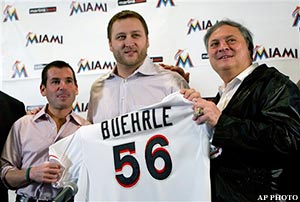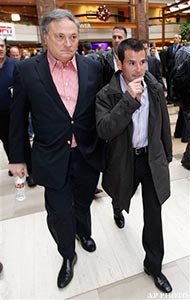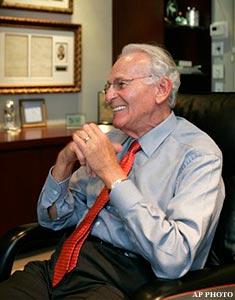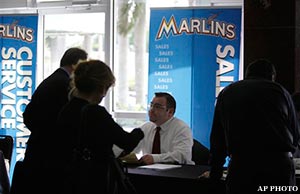The numbers are staggering. Jose Reyes, $106 million. Mark Buehrle, $58 million. Heath Bell, $27 million. A reported $10 million for manager Ozzie Guillen, who according to rough sabermetric consensus is worth, at most, an extra three wins a season. Oh, and don't forget a $200 million offer to Albert Pujols, the prize pony of this year's free agent class.

To say that the notoriously parsimonious Miami Marlins -- what if Scrooge McDuck owned a baseball team, and also fancied teal? -- are suddenly throwing around greenbacks like drunken sailors isn't just clichéd; it's an insult to Joseph Hazelwood. And also a bad analogy. Because frankly, the Marlins aren't spending like intoxicated swabbies with a few hours of shore leave. They're spending like perfectly sober investment bankers.
The former uses their money.
The latter uses yours.
And that's why it's time to Occupy the Marlins.
Following the financial meltdown of 2008, President Bush diagnosed the deus ex machina of the Great Recession like this: "Wall Street got drunk." He was wrong. Wall Street did not get drunk. Wall Street got over. Wall Street made billions underwriting crappy mortgagees, repackaging them as Triple-A investments and peddling them to naïve investors (read: your 401(k), state pension plans); made billions more placing side bets on and against the preceding criminal, but not technically criminal practice; made billions on top of that when the whole unsustainable shell game went belly up, thanks to a massive, unprecedented influx of taxpayer cash -- again: your money -- via TARP and the Federal Reserve's money-for-nothing "discount window," which in turn allowed financial houses to keep handing out the kind of outsized salaries and bonuses that had the encamped residents of Zuccotti Park so peeved.
Over in the sports world, the Marlins are running the same basic con.
"They're finally spending money? That's a misnomer," says Ken Reed, Sports Policy Director for the League of Fans, a Washington, D.C.-based fan advocacy group affiliated with consumer advocate Ralph Nader. "To me, it's more like taxpayers have funded the entry fee into this high-priced fantasy league, and the Marlins are going off and buying players with our money. I think this will go down as the ultimate case of corporate sports welfare gone bad."
Sick of corporate bailouts? Occupy the Marlins.
Tired of seeing your hard-earned tax dollars line the pockets of people already in the top one percent of income earners, such as Goldman Sachs executives and team owners and goateed closers? Occupy the Marlins.

Looking to take a stand against the ever-escalating cost of being a sports fan, ever-escalating government spending or the ever-escalating sense that wealthy special interests are taking the general public for a ride? Occupy the Marlins.
The time is now.
Admittedly, the place is a bit unexpected.
For most of their 18-year history, the Marlins have pinched pennies with a vigor typically reserved for turning coal into diamonds. Twice, the franchise won the World Series; twice, it immediately dismantled its roster in fire-sale fashion, the better to avoid paying star players market-level salaries. And that was just fine. It's a free country. No public subsidy, no problem.
But no longer. Last week, the Marlins spent $191 million on three players -- almost as much as the $210 million the club spent on its total roster combined during the past six seasons. Reportedly, the team is looking to add more talent, presumably followed by additional champagne toasts on the club's private jet. What changed? Only this: The franchise is moving into a new $634 million ballpark, a retractable roof Xanadu-cum-stadium-sized ATM in Little Havana that figures to make team owner Jeffrey Loria even richer, largely because he:
(a) Didn't have to pay for most of its construction;
(b) Won't have to share the majority of the income generated by the building with the good people of Florida and beyond, all of whom who are footing the bulk of the aforementioned bill.
Obviously, this is nice work if you can get it. (It helps to own a baseball team, and helps even more to make noises about moving your baseball team). The deal breaks down as follows: City and county taxpayers are on the hook for $100-plus million in parking garage construction; a $35 million loan to the Marlins; $12 million for road repairs and other incidental costs; and over $347 million in ballpark construction bonds, which will actually cost the public more than $2 billion over the 40 years it takes to repay them.

Naturally, local politicians agreed to this during the deepest part of the recession, when bond terms were lousy and other essential government services were being slashed and buildings like the Miami Convention Center were in need of repair; naturally, they did this while raising area property taxes in order to close a $444 million budget gap; naturally, they're funding much of the scheme with tourist-soaking hotel bed taxes and
parking fees, which means they're trying to pass the outrageous cost of an inessential and fundamentally local bauble on to the rest of the nation. Or at least the rest of the nation that likes vacationing on South Beach.
Next time you book a room at the Delano, send a copy of the bill to Guillen.
In return for the above multibillion-dollar outlay, the city gets ... a baseball team. The exact same baseball team it already had, only with newer, uglier uniforms.
Meanwhile, the Marlins get to splurge on players, a plan club president David Samson (pictured at right with Loria) said was hatched upon receiving stadium approval. Of course it was. After all, the Marlins will receive almost every conceivable revenue stream from the new ballpark -- naming rights and concessions and ticket sales, including non-baseball events like concerts and soccer matches -- while spending just $120 million on construction and $2 million in annual loan repayments.
The team also will enjoy a 74-foot-high outfield sculpture designed by pop artist Red Grooms that features mechanical jumping marlins and diving seagulls, a Chuck E. Cheese-shaming $2.5 million animatronic wonder paid for not by art-dealing team owner Loria, but rather by -- you guessed it -- Miami-Dade County's Art in Public Places department..
In most walks of life, this is called larceny; in baseball, it's called Tuesday.
"You are talking about an ownership group that lied to the public and came away with hundreds of millions of dollars on the basis of those lies," says Dave Zirin, author of "Bad Sports: How Owners Are Ruining the Games We Love." "And instead of paying a penalty for it, they've been rewarded. It's all from the public till."
In the manner of Wall Street pushing sliced-n-diced subprime mortgages as low-risk investments, the Marlins have played fast and loose with the truth. While lobbying for a new stadium, the team repeatedly cried poor,
publicly refuting a Forbes report that it turned a $43.7 million profit in 2008. The club also refused to open its books to city officials -- a curious refusal that became decidedly less so in 2010, when leaked financial documents revealed that the Marlins made $48.9 million in profits in 2008-09. The leak infuriated many local lawmakers, and the general lopsidedness of the stadium deal was a major factor in the recall of Mayor Carlos Alvarez, a key supporter of the new ballpark.

Earlier this month, the Securities and Exchange Commission launched an investigation of the entire mess and the politicians involved, including a city commissioner who received more than $100 million for her district in exchange for her pro-stadium vote and a county commission chairman who received $40,000 in campaign donations from firms interested in bidding on the construction project.
Coincidentally -- or perhaps not -- the SEC is the same federal agency tasked with policing Wall Street.
"The Marlins were basically financed in a shell game involving community redevelopment dollars, dollars that should have been set aside to fight urban blight," says Norman Braman, a Miami-area car dealer who fought against the stadium's construction. "If the team was paying a proper rent for the stadium, if they paid real estate taxes, if some of the revenues would flow to the country, that would have been fine and I don't think the public would have had a problem with it. But the taxpayers never had a say. Politicians never put it in a referendum. They knew it would go down."
Braman (at right), the former owner of the Philadelphia Eagles, is something of an anomaly among his peers -- which is to say, he has fought against sports welfare. In the early 1980s, he led a successful campaign to nix a proposed city sales tax that would have built a new downtown stadium for Miami Dolphins owner Joe Robbie; more recently, he went to court to halt construction of the Marlins stadium and then spent a reported $1 million of his own money to support Alvarez's recall.

The suit and the election were steps in the right direction. But neither is enough. Nor is an SEC investigation, no matter the outcome. Occupation is the answer. Tents outside the will call window. Drum circles down the third base line. Guy Fawkes masks and handmade protest signs. Because the institutionalized grifting at the heart of Marlins' recent spending spree – the brazen looting of the public treasury, of funds that otherwise could pay for schools and roads and cops and hospitals, by selfish, toy-owning millionaires who don't even need the money -- isn't simply Florida's problem.
It's America's problem, too.
It's a problem in Minneapolis, where the Minnesota Vikings are threatening to leave unless citizens fund a Metrodome replacement. It's a problem in Indianapolis, where local government cut arts funding to plug a $47 million operating deficit created by subsidies for Lucas Oil Field and Conseco Fieldhouse. It's a problem in Hamilton County, Ohio, where the $30-plus million annual debt service on publicly financed Paul Brown Stadium accounted for 16.4 percent of the county's total 2010 budget and a local official calls the Cincinnati Bengals' home "the monster that ate the public sector." (County commissioners who approved the stadium deal -- one of whom now works for the Bengals -- reportedly even promised to pay for future upgrades, including a "holographic replay machine." No joke.)
According to a study released by the University of Utah's Center for Public Policy and Administration, 28 new major league sports stadiums were built between 2000 and 2008 at a combined cost of more than $9 billion -- and more than $5 billion of that total came from public coffers.
In short, sports welfare is pretty much a problem everywhere. And if you've paid attention to the news lately -- social service cuts, broken budgets, a looming nationwide municipal debt crisis -- it's a problem none of us can afford.
"The Marlins stadium deal was a little more blatant than some of the other deals, because they went in saying, 'we're broke' when they weren't," says Neil deMause, author of "Field of Schemes" and expert on stadium finance boondoggles. "But it's not really that different than all sorts of other stadium deals. Like the [Washington] Nationals, where the team said they couldn't survive without a new park, and the public stadium subsidy basically went to boost the sale price of the team for Major League Baseball. Even the [New York] Yankees got tons of subsidies for their new stadium. And they make tons of money."

Proponents of public stadium financing argue that public stadium financing is a good deal because having sports teams turbocharges local economies. Hogwash.
Independent study after independent study has found the economic impact of stadium construction negligible at best and a net negative at worst – in part because sports teams create a minimal number of low-paying, part-time jobs; in part because money spent at ballgames is simply shifted from other local entertainment options. The big winners? Team owners, who watch their franchise resale values skyrocket. Otherwise, as Zirin often says, public financing accomplishes one thing: Socializing the debt and risk of pro sports while privatizing the profits.
Never mind the Occupy movement -- isn't that exactly the kind of public policy outcome that has the Tea Party so bent out of shape?
Of course, there's a better way. A way to stop the stadium scam. A way to make sure taxpayers never again spend money they can't afford to bribe sports teams they can't bear to lose while subsidizing the trust funds of Reyes' future grandchildren. Occupy the Marlins.
Forget hope -- and by hope, I mean hoping that Buehrle and Bell are generous tippers. Instead, demand change. Demand that sports franchises share their profits with the same cities and counties that are sharing their costs of business. Demand that Congress eliminate the antitrust exemptions that allow leagues to act as unregulated monopolies, playing the build-or-we'll-move stick-up game, over and over again. Demand that Loria pick up the tab for his debt-bomb stadium, or at least for his silly mechanical outfield fish.
"We have some of our nation's wealthiest people owning these franchises in a self-regulated monopoly industry that allows them to pursue their profit agendas at the expense of fans and the best interests of the game," Reed says. "It's totally irrational to put sparkling new sports palaces in the same category as public works projects like new bridges, police, firefighters. It's the most irrational thing in American public policy."
A former sports marketer, Reed once hawked suites for the Philadelphia Eagles. By day, he would pitch businesspeople on the merits of shrimp cocktail and Andy Reid, often pitting rival companies against each other.
"If Brand X sees Brand Y has a suite, they say, 'We have to have one, too,'" he says. At night, however, Reed was sleepless. He had a longtime passion for sports, and couldn’t shake the voice in his head: You're feeding the beast. You're making sports worse.
Presumably, Loria and his ilk sleep soundly. Perhaps they shouldn't. Perhaps Occupying the Marlins could change that.
It's time. Time to demand accountability and respect. Time for the public to be treated as a partner, as opposed to goodie-stuffed piñata. Time for hustling, greedy, parasitic sports owners to stop embodying the funny but telling statement once uttered by former baseball owner Bill Veeck: We play "The Star Spangled Banner" before every game -- you want us to pay taxes, too?
Patrick Hruby is a culture writer for the Washington Times. His work has appeared in the Best American Sports Writing series. Follow him on Twitter @patrick_hruby and contact him at PatrickHruby.net.




